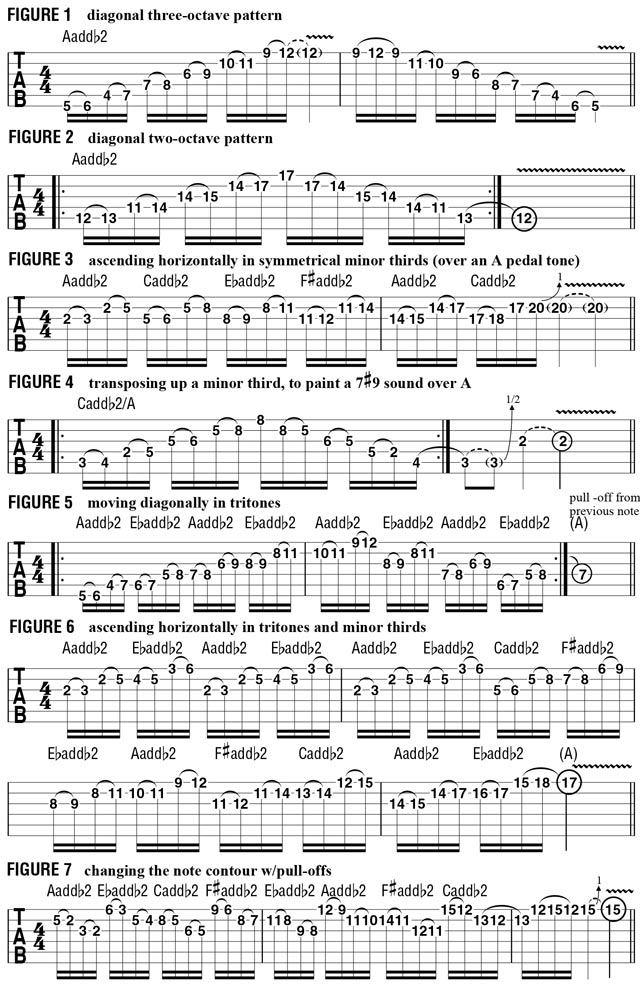Eerie Arpeggios: Using Movable Addb2 Shapes to Create Haunting Lead Lines
Learn how to create eerie, twisted-sounding melodies with this lesson.
Taking an ominous detour from last month’s regal-sounding add-2 arpeggios and “French horn fifths,” I’d now like to entice you to come to the dark side, musically speaking, and show you how to create eerie, twisted-sounding melodies, using a slight variation on the four-note structure we’ve been working with.
What we’re going to do is take our major 1-2-3-5 sequence and lower, or “flat,” the 2, so that we have 1-b2-3-5. This produces an intriguingly odd sound that may be described as being both bright and dark, or “good and evil.”
FIGURE 1 shows an Aaddb2 arpeggio (A Bb C# E) played diagonally across the fretboard through three octaves.
What we’re doing here is taking a four-note shape, or “module,” playing it first on the bottom two strings, then an octave higher on the middle two strings, then an octave higher on the top two strings. We then reverse the octave transposition—high, middle, low.
FIGURE 2 offers a similar pattern that starts on the fifth string and sequences through two octaves. I’m using all available hammer-ons and pull-offs with these figures, in order to facilitate a smooth performance and achieve a flowing, saxophone-like legato sound, a “soft” articulation approach pioneered and popularized by the late, great fusion guitar legend Allan Holdsworth. I encourage you, however, to also try alternate picking the notes, both with and without palm muting.
FIGURE 3 offers an “outside”-sounding run that climbs horizontally up the neck, staying on the G and B strings exclusively. Here we’re taking a four-note add-b2 shape and symmetrically transposing it up in minor thirds, shifting it up three frets on each subsequent beat. This sequence sounds pretty otherworldly and nightmarish when played over an A bass note or chord and gives you all the notes of the rather complex and enigmatic-sounding A half-whole diminished scale (A Bb C C# Eb E F# G), which is an eight-note entity, intervallically spelled 1 b2 b3 3 b5 5 6 b7.
One particularly cool and useful thing the previous example demonstrates is how a Caddb2 arpeggio (C Db E G), when played over an A bass note or chord, gives you a bluesy A7#9 sound (A C# E G C), minus the A root note, which is provided by the accompaniment and harmonic context.
All the latest guitar news, interviews, lessons, reviews, deals and more, direct to your inbox!
Play the lick in FIGURE 4 over a low A pedal tone, and you’ll hear this. So the improvisational-compositional device here is to play a major add-b2 arpeggio up a minor third from your tonal center to create a dominant seven sharp-nine sound. FIGURE 5 is another eerily cool “nightmare” run. Here we’re moving diagonally across the neck in alternating tritones, utilizing all of the two-string, four-note shapes introduced in FIGURES 1 and 2.
FIGURE 6 combines alternating-tritones with the sequencing-up-in-minor-thirds pattern from FIGURE 3, in this case climbing up the G, B and high E strings while alternating between two shapes and string pairs. As an alternative-contour option, you could play the notes of an ascending shape in reverse order, descending, leading with the pinkie and using pull-offs, as demonstrated in FIGURE 7. Again, experiment with using alternate picking too.

Over the past 30 years, Jimmy Brown has built a reputation as one of the world's finest music educators, through his work as a transcriber and Senior Music Editor for Guitar World magazine and Lessons Editor for its sister publication, Guitar Player. In addition to these roles, Jimmy is also a busy working musician, performing regularly in the greater New York City area. Jimmy earned a Bachelor of Music degree in Jazz Studies and Performance and Music Management from William Paterson University in 1989. He is also an experienced private guitar teacher and an accomplished writer.

